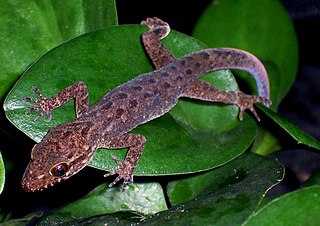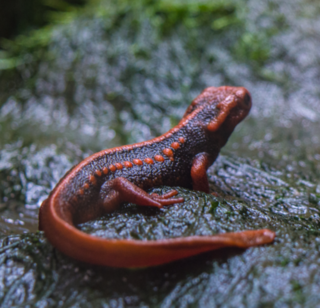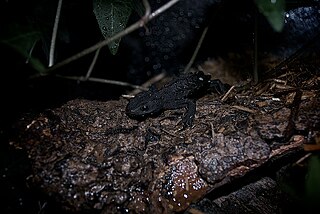
Cyrtodactylus is a diverse genus of Asian geckos, commonly known as bent-toed geckos, bow-fingered geckos, and forest geckos. The genus has at least 300 described species as of 2020, which makes it the largest of all gecko genera.

Salamandridae is a family of salamanders consisting of true salamanders and newts. Salamandrids are distinguished from other salamanders by the lack of rib or costal grooves along the sides of their bodies and by their rough skin. Their skin is very granular because of the number of poison glands. They also lack nasolabial grooves. Most species of Salamandridae have moveable eyelids but lack lacrimal glands.

Tylototriton shanjing, the emperor newt, Mandarin newt or Mandarin salamander, is a highly toxic newt native to China.

Tylototriton verrucosus is a species of newt found in the Indian subcontinent and Southeast Asia. Common names include: Himalayan newt, crocodile newt, crocodile salamander, Himalayan salamander, red knobby newt.

Tylototriton is a genus of newts known as crocodile newts or knobby newts. About 36 known species are in this genus. Many species have been described just recently. They range from northeastern India and Nepal through Burma to northern Thailand, Laos, Vietnam, and southern China.

Paramesotriton, also known as warty newts or Asian warty newts, is a genus of salamanders in the family Salamandridae. The genus is found in southwestern and southern China and in northern Vietnam. Most of the species are endemic to China, and the majority of them have been described recently, since 2008. The genus includes both pond and stream dwellers.

The black knobby newt is a species of salamanders in the family Salamandridae found in China and Vietnam. Its natural habitats are subtropical or tropical moist lowland forests, subtropical or tropical moist montane forests, freshwater marshes, and intermittent freshwater marshes. It is threatened by habitat loss and overharvesting.
The Hainan knobby newt is a species of salamander in the family Salamandridae. It is found only in the island of Hainan, China. It is known from the Wuzhi Mountains, Diaoluoshan, and Jianfengling. All these locations are nature reserves. Nevertheless, the species is threatened by habitat loss and degradation due to agriculture, clear-cutting and infrastructure development for tourist activities.
The red-tailed knobby newt or Kweichow (crocodile) newt is a species of salamander in the family Salamandridae. It is found in western Guizhou and north-eastern Yunnan, China. It is most closely related to emperor newt and Himalayan newt.
The Taliang knobby newt is a species of salamander in the family Salamandridae. It is found only in southern Sichuan, China. It inhabits densely vegetated forested valleys, where it breeds in pools, ponds and paddy fields. It is a common species within its confined range.

The Wenxian knobby newt or Wenxian knobby salamander is a species of salamander in the family Salamandridae. It is endemic to central China. Its type locality is Wen County in Gansu, or in Chinese: 文县; pinyin: Wénxiàn, hence the name.
Tylototriton vietnamensis, the Vietnamese crocodile newt or Vietnamese knobby newt, is a species of newt in the family Salamandridae. It is known from four localities in northern Vietnam where it occurs in and near ponds within dense bamboo vegetation. It is quite likely that it also will be found in adjacent areas of China and possibly Laos. It is possible that specimens earlier identified as T. asperrimus are in fact T. vietnamensis. However, based on molecular genetic data, its closest relative is T. hainanensis.
Tylototriton notialis, the Laos knobby newt, is a species of newt in the family Salamandridae. It is only known from its type locality in the Nakai-Nam Theun Biodiversity Conservation Area, Khammouane Province, central Laos. The type locality is an evergreen mixed deciduous–pine forest; the newts were found in and near a small stream. It is likely that Laos knobby newt will also be found in adjacent areas of Vietnam. Based on molecular genetic data, it belongs to the Tylototriton asperrimus group of knobby newts. Laos knobby newt is a small newt, with total length of about 11–14 cm (4.3–5.5 in).

Tylototriton ziegleri, also known as Ziegler's crocodile newt or Ziegler's knobby newt, is a species of newt in the family Salamandridae. It is currently known from Hà Giang and Cao Bằng provinces in northern Vietnam, although its actual range probably wider; there is a photograph to suggest it also occurs in Lào Cai Province in Vietnam, and its range likely extends to Yunnan in southern China. Based on molecular genetic data, Tylototriton ziegleri belongs to the "Tylototriton asperrimus group" of newts. The specific name ziegleri honours Thomas Ziegler, a German herpetologist.

The Balkan crested newt or Buresch's crested newt is a newt species of the crested newt species complex in genus Triturus, found in Southeastern Europe and Anatolia.

Triturus macedonicus, the Macedonian crested newt, is a newt species of the crested newt species complex in genus Triturus, found in the Western Balkan peninsula.
Tylototriton panhai is a newt found in Thailand and Laos. It was recently distinguished from Tylototriton shanjing by Nishikawa et al., 2013.
Tylototriton uyenoi, the Chiang Mai crocodile newt, is a newt endemic to Chiang Mai Province, Thailand. It was distinguished from Tylototriton shanjing, the emperor newt, in 2013. The species was named in honor of herpetologist Shun-ichi Ueno. T. uyenoi is one of the few salamander species endemic to Thailand.
Tylototriton shanorum is a newt endemic to Shan State, Myanmar, where it was recorded in Taunggyi.

The angular-headed newt, also known as angular-headed crocodile newt, is a species of salamander in the family Salamandridae from Thailand, Laos, and Vietnam. Its unique orange markings help to distinguish it from other species, and also gave it the nickname "Star-Trek newt", as it resembles the ridges on the head of the fictional Klingon species from the television show Star Trek.











